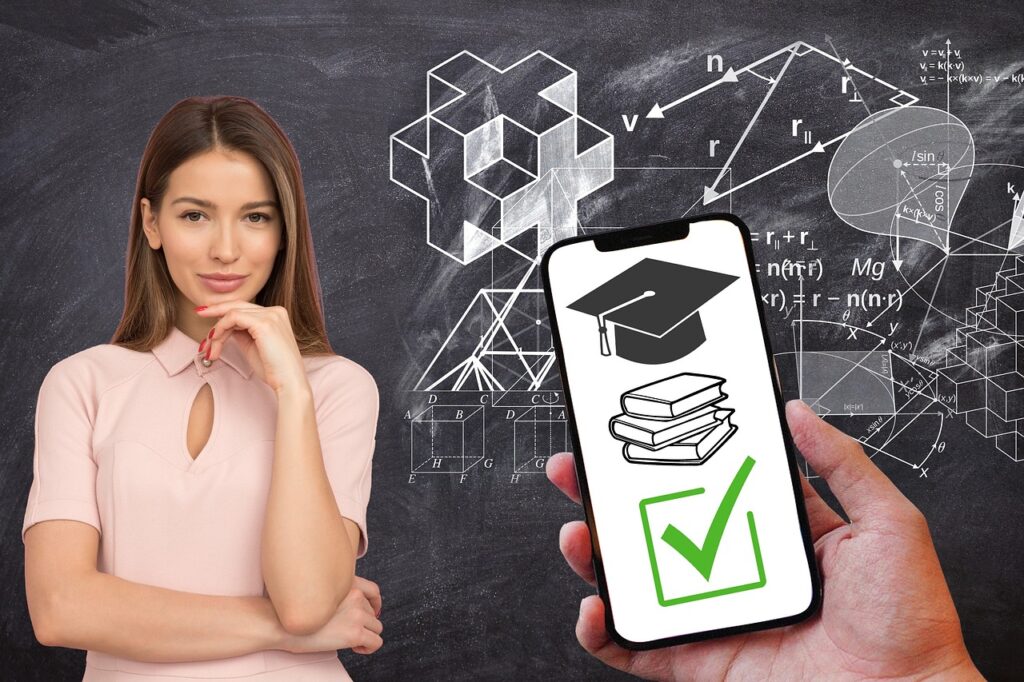Can Technology Replace Teachers

Introduction:
Can technology replace teachers in today’s quickly evolving technological landscape? This is a question that comes up a lot. There’s no doubting that technology has completely changed the way we approach education, as evidenced by the rise of AI-driven educational platforms, virtual classrooms, and interactive learning tools. But can it really take the place of the knowledge and human touch that teachers provide? Let’s explore this argument in more detail.
The Rise of AI in Education:
The field of artificial intelligence (AI) has revolutionized a number of industries, including education. AI-powered learning environments use machine learning algorithms to assess student data, tailor lessons, and offer focused interventions. Distance learning options are made possible by virtual classrooms, which dismantle geographical constraints and increase educational access. Interactive educational resources, including instructional games and simulations, immerse students in the classroom and increase the effectiveness and enjoyment of learning.
Read also – Beyond the Bottle: Owala’s Commitment to Sustainability in Every Sip

The Human Element in Education:
Even with technological developments, human interaction is still crucial in education. Technology cannot replace the richness of knowledge, experience, and empathy that teachers bring to the classroom. An effective teacher may establish a personal connection with each student, get to know their unique requirements and learning preferences, and adjust the curriculum accordingly. Teachers help students become well-rounded people by teaching them important life skills, social and emotional learning, and character development in addition to academic knowledge.
The Role of Teachers in Fostering Critical Thinking:
Encouraging students to think critically is one of the main goals of education. Technology can distribute knowledge and administer tests automatically, but it sometimes lacks the complexity and nuance needed to foster critical thinking skills. Teachers challenge students to think critically, examine data, and develop well-reasoned arguments by acting as mentors and facilitators. Through thought-provoking conversations, inquiry-based learning exercises, and Socratic questioning, educators empower students to challenge presumptions, take into account different viewpoints, and cultivate independent thought.
The Importance of Emotional Intelligence:
Empathy, self-awareness, and social skills are traits of emotional intelligence, which is a key component of successful teaching and learning. In their classrooms, teachers foster a caring and supportive atmosphere that makes students feel appreciated, respected, and inspired to learn. By offering emotional support, constructive criticism, and encouragement, they assist pupils in overcoming obstacles and developing resilience. Teachers also act as role models, exhibiting the kindness, understanding, and respect that are necessary for success in both the personal and academic spheres.
The Benefits of Technology in Education
Prior to diving straight into the subject, let us first recognize the many advantages that technology offers the educational sector. Technology has the ability to improve accessibility, engagement, and personalization of learning. Students have instant, anywhere access to a multitude of knowledge thanks to online resources. Immersion experiences that accommodate a variety of learning preferences are provided by interactive learning platforms, which improve conceptual comprehension and recall. Technology also helps teachers to better monitor their students’ progress, pinpoint areas that need work, and offer focused assistance.
Accessibility:
Thanks to technology, educational opportunities are now much more accessible, removing obstacles based on financial class, geography, and physical impairments. Regardless of their location or background, students can learn at their own pace and convenience with the help of digital materials and online learning platforms. This accessibility creates chances for lifetime learning and skill development for students who might not have had access to traditional educational programs.
Read also – Can Food Poisoning Cause Fever

Engagement:
Students’ attention is captured and learning becomes more interesting and pleasurable through the use of interactive learning technologies, multimedia materials, and gamified learning experiences. Technology encourages student participation and increases motivation by introducing interactive features like simulations, quizzes, and virtual labs. Additionally, multimedia materials like films, animations, and interactive infographics support both aural and visual learning, accommodating a range of learning styles and improving understanding and memory of information.
Personalization:
Personalized learning experiences that are catered to each student’s requirements, interests, and learning preferences are made possible by technology. Customized learning paths and content recommendations are generated by adaptive learning algorithms through analysis of student data and performance indicators. With this individualized approach, every student is guaranteed to receive focused instruction and support, allowing them to reach their full learning potential. Technology also helps with differentiated education, which enables educators to modify their lesson plans and instructional resources to suit the various learning styles and needs of their students.
Collaboration:
Regardless of physical proximity, collaborative learning platforms and communication technologies support student cooperation and teamwork. Students can communicate, share ideas, and collaborate on projects in real time using online discussion boards, virtual classrooms, and online collaboration spaces. Students gain vital cooperation, communication, and problem-solving skills via collaborative learning experiences, equipping them for success in a collaborative and linked society.
Assessment and Feedback:
Technology makes evaluation easier and gives students rapid, focused feedback. Online assessment technologies that efficiently analyze student learning outcomes and give instant feedback on performance include surveys, quizzes, and automatic grading systems. Additionally, learning management systems and data analytics give teachers the ability to monitor their students’ progress, spot their areas of strength and weakness, and offer tailored support when needed. This data-driven method of assessment and feedback encourages ongoing development and helps the learning and development of students.
The Role of Teachers in Education:
It’s important to acknowledge the indispensable function that teachers play in the learning process, even while technology unquestionably improves the educational experience. Teachers are mentors, facilitators, and sources of inspiration in addition to being information providers. A proficient educator has the capacity to foster in their pupils an appreciation for critical thinking, creativity, and interpersonal skills. They offer direction, inspiration, and personalized help that technology cannot match. Teachers also act as role models, passing along priceless life skills and values in addition to academic information.
Facilitators of Learning:
Teachers assist learning by acting as guides and by fostering an atmosphere that encourages inquiry, investigation, and discovery. They choose teaching resources, develop lesson plans, and produce educational activities that meet the various needs and interests of their pupils. Teachers cultivate a culture of curiosity, engagement, and academic rigor by utilizing effective pedagogy and classroom management approaches.
Read also – Wine Mathematics: How Many Glasses in Your Bottle?

Mentors and Coaches:
In addition to teaching, educators serve as coaches and mentors for their pupils, helping them grow both personally and academically. They support students in overcoming obstacles, setting goals, and succeeding by providing them with inspiration, motivation, and helpful criticism. Teachers encourage students to realize their full potential and follow their dreams by offering mentorship and direction.
Cultivators of Critical Thinking:
One fundamental ability necessary for success in the twenty-first century is critical thinking. By encouraging students to critically analyze information, assess supporting data, and present well-reasoned arguments, teachers can significantly contribute to the development of critical thinking abilities in their pupils. By means of stimulating conversations, problem-solving exercises, and inquiry-based learning opportunities, educators cultivate students’ critical thinking abilities and intellectual curiosity.
Promoters of Creativity and Innovation:
Teachers foster creativity and innovation in their pupils by giving them opportunity for experimentation, expression, and exploration in addition to imparting academic knowledge. They promote risk-taking, creative problem-solving, and divergent thinking, which helps to create an innovative learning environment in the classroom. Teachers encourage pupils to think creatively and beyond the box by incorporating design thinking, the arts, and project-based learning into the curriculum.
Builders of Relationships and Communities:
Teachers and students develop enduring bonds based on empathy, respect, and trust. They establish a welcoming and inclusive learning environment in the classroom where each student is made to feel important, accepted, and empowered to study. Teachers establish a healthy learning community that increases student engagement and accomplishment by celebrating diversity, encouraging cooperation, and helping students feel like they belong.
Agents of Social Change:
By instilling in their students the ideals of equity, justice, and social responsibility, teachers have the ability to affect social change. They help kids become responsible citizens and future leaders of the world by fostering empathy, compassion, and respect for diversity. Through community involvement programs, service learning projects, and civic education, educators enable students to advocate for social justice and equity and to positively impact their communities.
The Limitations of Technology:
When it comes to education, technology has its limitations despite its numerous benefits. The lack of empathy and emotional intelligence that AI-driven systems inherently possess is one of their biggest disadvantages. Although technology is capable of delivering content and evaluating learning outcomes, it frequently fails to recognize the distinct requirements and motivations of individual students. Furthermore, there is still a digital gap, with differences in access to technology escalating educational inequality. Moreover, an over dependence on technology could impede the growth of crucial interpersonal abilities including cooperation, communication, and teamwork.
Lack of Emotional Intelligence and Empathy:
The fact that technology cannot perfectly replace human traits like emotional intelligence and empathy is one of its biggest drawbacks in education. Even though AI-driven systems are capable of delivering content and performing automated assessments, they frequently lack the social and emotional intelligence necessary to comprehend and react to human interaction’s subtleties. Teachers are able to relate to students on a personal level, identify their unique needs and motivations, and offer tailored assistance and encouragement. Building trust, rapport, and a sense of belonging in the classroom—all of which are critical for student engagement and wellbeing—requires this human aspect.
Read also – Cleanse Your Way to Wellness: The Ultimate Colon Broom Review

Digital Divide:
Even with the extensive use of technology in education, there are still differences in students’ access to technology and digital resources due to the existence of the “digital divide.” Access to technology is significantly influenced by socioeconomic factors, including infrastructure, geographic location, and income level. Students from underprivileged backgrounds may find it difficult to access online learning opportunities because they lack access to dependable internet connectivity, devices, and digital literacy skills. By expanding the gap between students who have access to technology-rich learning environments and those who do not, the digital divide exacerbates already-existing educational inequities.
Over-reliance on Technology:
Technology can improve education, but if it is used excessively, it can impede the growth of critical interpersonal skills like cooperation, communication, and teamwork. Students who spend too much time on screens and who passively consume digital content may have less opportunities for social engagement and in-person interactions. Success in academic and professional contexts depends on interpersonal skills, therefore educators need to find a balance between technology-mediated learning possibilities and opportunities for in-person engagement and teamwork.
Privacy and Security Concerns:
There are worries regarding data security and privacy due to the extensive use of technology in education. Massive volumes of student data, including performance indicators, learning preferences, and personal information, are gathered by educational technology platforms. To prevent unauthorized access, misuse, or exploitation of students’ sensitive information, it is imperative to ensure the privacy and security of this data. In order to secure student privacy and preserve confidence in educational technology solutions, educators and legislators need to put strong data protection mechanisms in place and follow stringent privacy legislation.
Depersonalization of Learning:
In large-scale online courses or automated learning environments, in particular, technology-driven educational practices may occasionally result in the depersonalization of learning experiences. Due to a lack of opportunities for meaningful contact and feedback from classmates and teachers, students may feel disengaged from the learning process. Fostering a sense of belonging and participation in the classroom, as well as meeting each student’s specific learning needs, requires tailored attention and tailored support. Teachers need to carefully use technology to enhance, not replace, the individualized touch of human interaction in the classroom.
Finding the Balance:
Striking the right balance is essential when managing the relationship between technology and education. Technology should be viewed as a tool to enhance teachers’ talents rather than as a substitute for them. Through strategic integration of technology into pedagogical methods, educators can craft valuable learning opportunities that optimize the best aspects of both worlds. Teachers can use technology to support socio-emotional growth, meaningful human relationships, and tailored feedback in addition to improving material delivery and facilitating collaboration.
Enhancing Teaching Practices:
Traditional teaching methods can be improved with the help of technology, becoming more efficient and interesting. Interactive whiteboards, educational applications, and multimedia materials, for instance, can enhance the way lessons are taught and accommodate a variety of learning preferences. Instructors can engage students’ interest and engagement by using digital technologies to produce multimedia projects, virtual field trips, and interactive presentations. Teachers may create dynamic learning experiences that capture students’ attention and encourage deeper learning by incorporating technology into their lesson plans.
Fostering Meaningful Human Relationships:
Even while technology is useful in education, real human relationships are still just as important to the learning process. Teachers act as guides, mentors, and role models for their students, offering them emotional support, motivation, and individualized instruction. Teachers who establish great relationships with their students foster a caring and supportive learning environment in which students feel respected, appreciated, and equipped for success. Technology may help teachers and students communicate, collaborate, and provide feedback—rather than taking the place of these interpersonal relationships.
Promoting Socio-Emotional Growth:
Education includes character development and socioemotional growth in addition to academic knowledge acquisition. In order to help kids develop social and emotional competencies like empathy, resilience, and self-control, teachers are essential. Technological resources and techniques that encourage self-awareness, forming relationships, and making responsible decisions can be strategically employed to assist socio-emotional learning programs. Digital platforms, for instance, can provide students with conflict resolution simulations, virtual peer support networks, and mindfulness activities to aid in the development of critical life skills and emotional intelligence.
Providing Tailored Feedback and Support:
Teachers may now give students timely, tailored feedback and help based on their unique learning preferences and requirements thanks to technology. Online tests, automatic grading tools, and learning management systems all simplify evaluation procedures and give students immediate feedback on their performance. Additionally, teachers may monitor student progress, pinpoint areas for development, and customize education to each student’s unique needs thanks to data analytics and learning analytics tools. Teachers can enable children to realize their full potential and thrive academically by using technology to provide focused interventions and assistance.
Encouraging Lifelong Learning:
Building a culture of continual learning is crucial for both professional and personal development in an ever-changing world. Technology provides limitless chances for independent study, discovery, and skill improvement outside of the conventional classroom. By teaching students how to use technology wisely to access learning resources, work with peers, and follow their interests and passions, teachers may enable their students to become self-directed learners. Teachers give pupils the skills and determination they need to succeed in a knowledge-driven world by fostering a growth mindset and a love of learning.






2 thoughts on “Can Technology Replace Teachers”